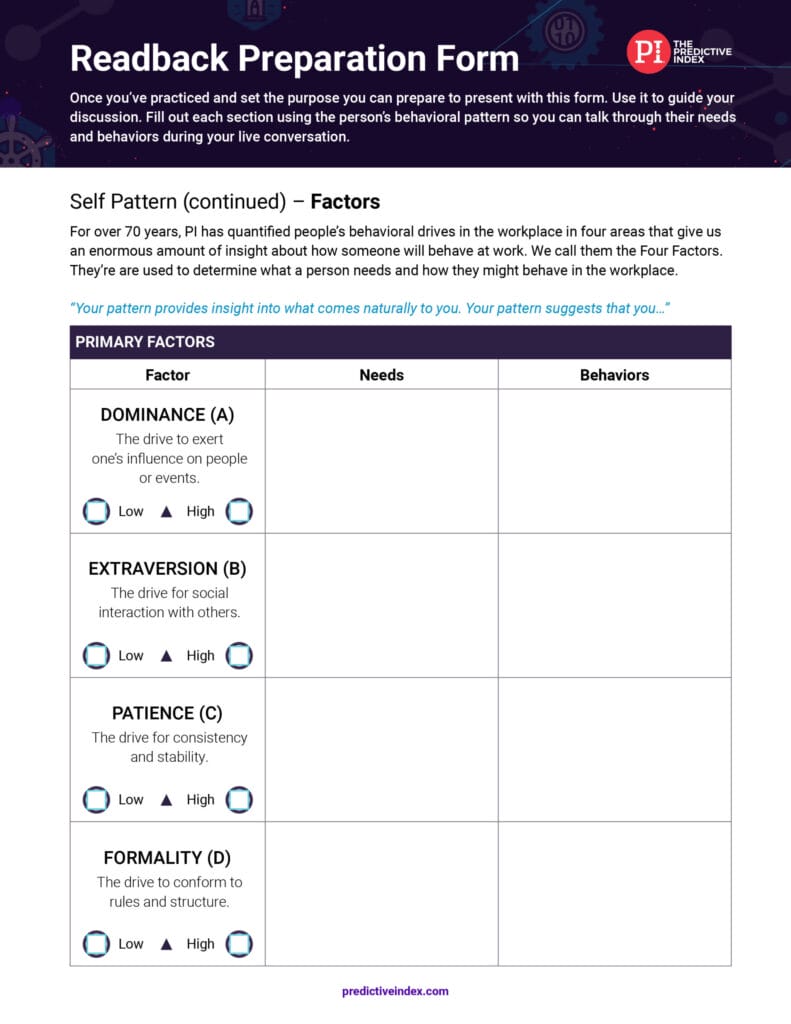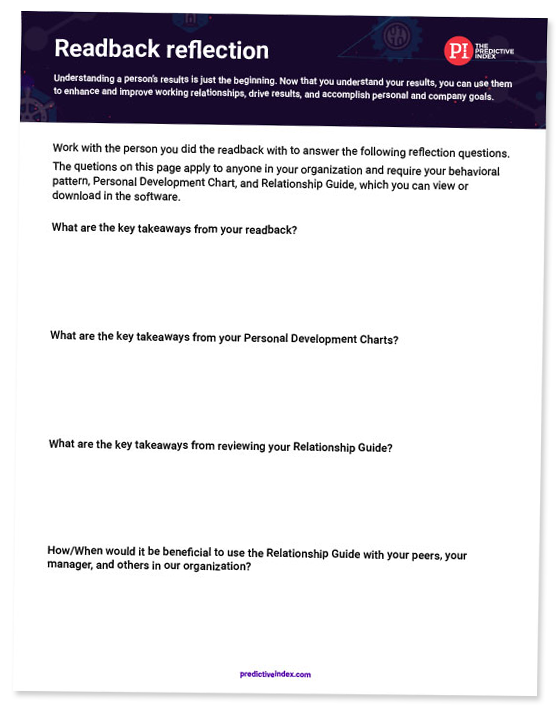Prepare for a Readback
Here are some tips for when it comes to practicing and preparing for a readback. We’re following the 4 P’s of providing a readback: Practice, Purpose, Prepare and Present. To view our readback video series, click here.
Practice
Providing great, conversational readbacks is a skill that is best developed with practice. No one is perfect their first time! Not only are you still learning to read and interpret Behavioral Assessment results, but it can take time to understand how the results might manifest themselves in a person’s behaviors.
We suggest doing practice readbacks on close coworkers, family or friends—whatever it takes to help build your readback confidence. Set a goal for yourself, such as giving 10 readbacks in 30 days. The more you do it, the easier and more natural it becomes!
Purpose
Knowing the purpose could change how you approach the conversation. What are you trying to accomplish with the readback conversation? This is helpful for you and for the person you’re doing a readback with. Often, we are using this conversations as:
- A quick, high-level feedback session to provide a general sense of what the Behavioral Assessment measures and what it reveals about the person, without diving into the individual Factors and Factor Combinations. This is often done during onboarding with a new employee or manager.
- An in-depth conversation that reviews the Factors and Factor Combinations and how the results relate to on the job performance and relationships. This is often done when talking about how someone is performing in their role, on the team, or on a specific project.
- A coaching conversation to help create self-awareness and opportunities for development. This is often done when a manager and their direct report are talking about their professional development and growth within the organization.
- Something else. Understanding behavioral results helps everyone increase self-awareness to foster a healthy working environment. There are several opportunities during the course of the year where this data can help employees across the organization.
Prepare
Once someone has completed the PI Behavioral Assessment, review their results and use the features and guides in the software to help you accomplish the purpose for the conversation.
- Review their results, including Factors, Factor Combinations, Self and Self-Concept, and their Reference Profile.
- You may want to find out what you can about the person’s job. The more you know about their job, the more you can make connections regarding their natural and adapted behaviors.
- Anticipate questions that might come up so you feel prepared with answers.
- NOTE: If someone asks a question you don’t have an answer for, don’t guess or make up the answer. Make a note and reach out to the PI practitioner at your organization or your PI consultant. Let the person know you’ll get back to them with clarification.
Present
- Reassure the individual that there are no right or wrong answers or bad patterns. You’re reviewing this to help understand what they need to be happy and succeed in their role and to help foster healthy working relationships around the organization.
- Describe the person, not the pattern.
- Provide examples to help create a full picture.
- Pause and allow time for them to process the readback. Take breaks and ask, “Does this make sense?”, “Does that resonate with you?”
- Ask them if they have any questions. If someone asks a question you don’t have an answer for, don’t guess or make up the answer. Make a note and reach out to the PI practitioner at your organization or your PI consultant. Let the person know you’ll get back to them with clarification.
- Let them know if there are next steps or how their results might be reviewed and used at other times in their employee journey.
The Readback Preparation Form
Once you’ve practiced and set the purpose you can prepare to present with this Readback Preparation Form and use it to guide your discussion. Fill out each section using the person’s behavioral pattern so you can talk through their needs and behaviors.
Sample ways to begin the conversation
Continue the discussion and reflect
Understanding a person’s results is just the beginning. There are many features and guides in the software that can help everyone in your organization use behavioral data to enhance and improve their working relationships, to drive results, and to accomplish personal and company goals.
Reflection question: What are the key takeaways from your readback?
Personal Development Chart
Audience: All employees
The Personal Development Chart (PDC) provides insights into an employee’s behavior. It reviews their areas of strength and of caution as well as providing self-coaching tips for balancing their most commonly occurring behaviors.
We recommend sharing the PDC within 60-90 days of the employee’s completed Behavioral Assessment. The best practice would be for the manager and their direct report to review it together, as it provides a great opportunity for them to create an action plan to work towards their development in their role.
Reflection question: What are the key takeaways from your Personal Development Chart?
Relationship Guide
Audience: All employees
It’s vital for your everyone to know and understand how their colleagues show up in the workplace. The Relationship Guide compares the unique behavioral patterns of the two employees side by side and helps them understand:
- Their areas of strength so they can continue to practice them.
- Their areas of caution to be aware of as they work together.
- Tips to maintain a healthy working relationship.
Reflection questions:
1. What are the key takeaways from reviewing your Relationship Guide?
2. How/When would it be beneficial to use the Relationship Guide with your peers, your manager, and others in our organization?
Management Strategy Guide/Management Tips
Audience: Manager and Direct report
Using a list tailored to the direct report, managers can use the Management Strategy Guide to confirm the employee’s behavioral preferences and what they need to thrive in their day to day. This helps maximize effectiveness, productivity, and job satisfaction.
It should be reviewed by the manager and their direct report in a 1:1 meeting every 90 days to make sure there is alignment.
Reflection question: What are the key takeaways from the Management Strategy Guide/Management Tips?
Manager Development Chart/Management Skills Guide
Audience: Managers
This tool is designed to help you become a more empathetic and self-aware manager. It includes a description of the manager’s unique behavioral strengths, along with their potential caution areas. It also includes coaching tips to address those cautions and elevate their natural leadership style.
It should be reviewed any time the manager gets a new team member or any time they’re having coaching development conversations with their manager.
Reflection questions:
1. Based on what you just reviewed with your direct report or project team member, what are some key takeaways you notice as you review your Manager Development Chart/Management Skills Guide?
2. What are the strengths and caution areas you’ll need to be aware of, and potentially stretch, to support this employee?
Activity worksheet
Activity worksheet
Download our fillable Readback reflection activity worksheet and share it with your employees.
They can work in pairs to practice giving readbacks to increase their self-awareness and to help build relationships with each other. This is particularly helpful for new employees, managers and their direct reports, and those who work on teams or projects together.
To inform us of a typo or other error, click here. To request a new feature, click here.

